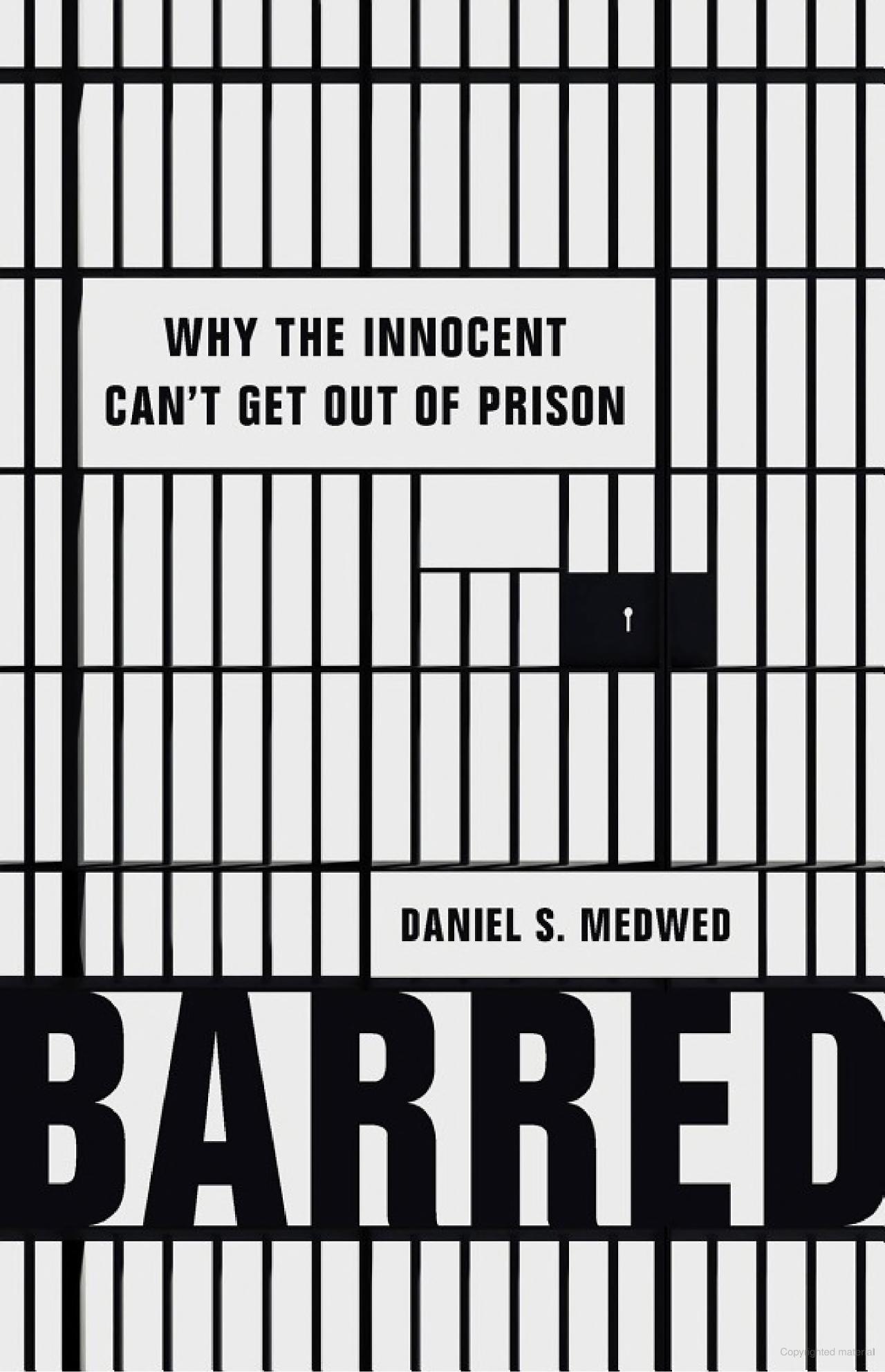Barred: Why the Innocent Can’t Get Out of Prison
Daniel S. Medwed
Basic Books, $30 (hardcover)
I know what it’s like to represent the innocent. I spent years working on behalf of a woman who, based on the dubious testimony of a single eyewitness, served nearly 30 years in prison for a robbery and murder she did not commit. I wrote a book, Case of a Lifetime, about the toll her wrongful conviction took on her, and on the lawyers representing her. I have represented other innocent people at trial too, although, thankfully, not too many. As the late Barbara Babcock once wrote, “Those rare trials of a defendant whom the lawyer truly believes to be innocent… are grueling and frightening experiences, in which the usual will to win is elevated to a desperate desire to succeed.”
It is easy to feel for an innocent person. But, for those of us drawn to criminal defense—perhaps especially indigent criminal defense—it is easy to feel for a guilty person, to recognize that person’s humanity, fallibility, and potential. Given the stakes our mostly guilty clients face in the criminal system, these trials are grueling and frightening, too. Guilty people are up against the same “bars” and barriers, the same cold-bloodedness, that Daniel Medwed writes about in his new book Barred: Why the Innocent Can’t Get Out of Prison.
Most people think that wrongful convictions rarely happen and are almost always “fixed.” Barred challenges these assumptions, and ably portrays the impenetrability of the criminal legal system once a person is convicted—no matter how questionable the original conviction. Medwed shows that the system cares more about efficiency, finality, and deference than accuracy. He also offers real-life narratives that reveal the human cost of these skewed values, including haunting stories of lives broken due to lengthy wrongful imprisonment, of those on sex offender registries unable to find a place to live or work, or those simply unable to rebuild their lives on the outside, and who die too soon and alone.
Barred is organized in four parts. The first explains the limited prospects of the appellate process for innocent people challenging their convictions after trial or a guilty plea. Innocent people who plead guilty have an especially hard time on appeal, no matter the circumstances of the plea, the overall lack of transparency of plea-bargaining, or the reasonable fear of an exorbitant “trial tax” (a higher sentence after trial). The second addresses the limited utility of the “great,” and “ancient” writs of habeas corpus and coram nobis, the Supreme Court’s hostility to claims of innocence, and the myriad problems with post-conviction DNA-testing laws. The third discusses the futility of seeking parole or clemency while maintaining innocence. In the final section, Medwed proposes two specific reforms: the creation of conviction review units within prosecutor offices and the establishment of innocence commissions, consisting of diverse members of the legal profession and the community, including formerly incarcerated people. Medwed also gives a tentative nod to the “progressive prosecutor movement,” as a sign of progress.
The book makes several essential points. Among them is the role that police and prosecutorial misconduct, along with defense lawyer incompetence, play in wrongful convictions. Medwed shows how little judges care about these pervasive problems, contorting themselves to find no error no matter how egregious the misconduct, like police and prosecutors hiding evidence that points to a likelier perpetrator.
Medwed is even brave enough to name an inept and feckless Massachusetts defense lawyer, Keith Elias, who didn’t like his clients sitting next to him at trial; he relegated them to the prisoner’s dock behind him, and, without divulging it to anyone, had previously represented three police officers involved in the murder case he was now defending. I wish he had named more police officers and prosecutors.
Medwed also writes persuasively about the continuing problem of mistaken identification—which is associated with more than 75 percent of DNA exonerations—and the resistance of appellate courts to grapple with it. Unfortunately, although we can improve identification procedures, craft better jury instructions, and educate the public about the unreliability of memory, this common feature of criminal trials will always present a challenge. I have always felt that one of the reasons eyewitness testimonies are so powerful, if fallible, is because jurors and eyewitnesses have something profound in common: they are both accidental participants in the trial. The eyewitness had the misfortune to observe a crime. Jurors had the misfortune to be summoned for jury duty and selected. This affinity makes jurors relate to eyewitnesses, no matter how much lawyers or judges might caution them about the fallibility of human perception, memory, and bias.
More from our decarceral brainstorm
Every week, Inquest aims to bring you insights from people thinking through and working for a world without mass incarceration.
Sign up for our newsletter for the latest.
Newsletter
Despite these trenchant critiques, however, Barred should not be seen as a plan for decarceration. American jails and prisons are not bursting at the seams because of innocence claims, but because we lock up too many people for too many things for too long. Put simply, mass incarceration is an outcome of the excessive punishment of so-called violent criminals, including people convicted of drug dealing, burglary, and murder. But our obsession with innocence is complicating. In fact, as Medwed’s book documents, it is part of what makes it so difficult for wrongly sentenced people to pursue justice.
Take parole, which Medwed justly exposes as a pipedream for anyone convicted of a serious, violent offense. He recounts the story of one woman with a strong claim of innocence who was convicted in a shaken baby case (she had babysat for an infant with a history of injuries likely caused by the baby’s father). She had a three-minute hearing at which the parole representative barely looked at her and gave no weight to her excellent behavior in prison, loyal family, and low chance of reoffending because she “kill[ed] an infant.” As Medwed writes, “responsibility, remorse, and atonement”—which are difficult for any person, innocent or not, to express—are the only things that matter before a parole commission or clemency board. These values are enshrined in these kinds of hearings, and in initial sentencings as well, because they supposedly shed light on a person’s true character. But, as Morgan Freeman exemplified in the movie Shawshank Redemption, responsibility and remorse can be recited in an apparently sincere set piece to no effect.
The way legal institutions understand innocence claims is also deeply influenced by race, class, and gender. Women in the criminal legal system, for example, represent only about 9 percent of exonerations in the United States, largely because they aren’t convicted of the kinds of crimes that yield biological material suitable for DNA testing, like rape. As of 2020, only eleven women have been freed through DNA, compared to hundreds of men.
Medwed reports that 40 percent of the crimes innocent women are convicted of involve children or loved ones in their care. The alleged crimes are often tragic accidents—an overwhelmed mom absent-mindedly leaving a baby in the car, a baby dying of SIDS, a child finding and ingesting toxic drugs—misconstrued as intentional or reckless behavior. Deep-seated sexism plays a role in these wrongful convictions; the accused women have violated their traditional role as caretakers.
This isn’t to say that Medwed’s proposals for change aren’t feasible—they might even make a difference, if not for the politics and vagaries of crime and punishment. Conviction integrity units are only as good as the prosecutors who staff them. They have done some good in Brooklyn and Baltimore, but it remains to be seen how effective they will be elsewhere, especially in offices run by other than progressive prosecutors. Medwed is wisely skeptical about giving prosecutors too much power in determining who is innocent and who is not. Innocence commissions sound good, but, again, it depends on the composition of such a commission, and what a person might have to give up for the privilege of entering this process. If these commissions are essentially a dressed-up version of executive clemency boards—an innocence star chamber with enormous discretion and no accountability—I prefer the adversary system, no matter its flaws. Attentive and resourceful appellate counsel might obtain more access to justice than a commission from on high.
In sum, Medwed’s Barred is essential reading for anyone interested in how the law treats innocent people who have been wrongly convicted. It illustrates through compelling narratives and astute analysis our post-conviction preference for finality over fairness for everyone—the innocent and guilty alike. Once convicted and incarcerated, our criminal legal system means for people to stay that way.
Image: Lucas Hoang/Unsplash


